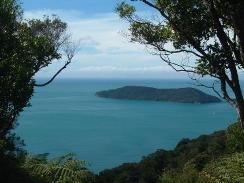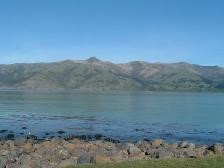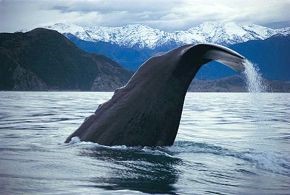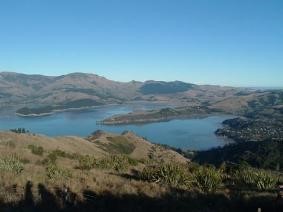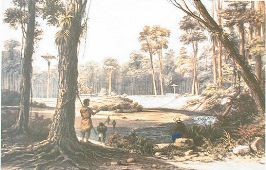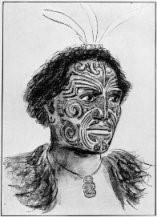Timeline
1769
|
When the Endeavour sailed from England, Captain James Cook had with him sealed orders to discover an immense land mass in the southern hemisphere. Reaching the coast of New Zealand in October 1769, he found islands covered in lush green forest with towering snow capped mountains and inhabited by native tribal communities. First arriving off the North Island's east coast, as had the Polynesian explorers one thousand years before, Cook eventually turned his ship and sailed north, anti-clockwise around the island before reaching Cook Strait and the South Island.
Having met with fear and resistance from natives in the North Island, Cook was pleased to gain friendship and trust among inhabitants of a large sound at the top of the southern island. On 31 January 1770, in the presence of a Maori chief, Captain James Cook raised the British flag at the summit of tiny Motuara Island and took possession of the mainland in the name of King George III. He named the beautiful sound after the King's consort Queen Charlotte. Finding perfect anchorage in Ship Cove, James Cook and the crew of Endeavour remained there long enough to refresh, refit and replenish before heading back out to the strait and sailing south down the east coast of the South Island. The second exploration and habitation of the islands of New Zealand had begun. |
1791
|
The first ship to enter Akaroa Harbour sailed from England and anchored off Onuku. Banks Peninsula was inhabited by the Ngai Tahu people, a large tribe of families intertwined by centuries of kinship and alliances living in a relatively peaceful society that stretched throughout the South Island. The serene harbour was to become the scene of more than one catastrophoic event for Ngai Tahu, and the whole region continues to hold great historical and cultural significance for the tangata whenua, people of the land. On May 28 1840 the Treaty of Waitangi was signed at Onuku.
The Chatham Islands were discovered by Lt William Broughton on the ship HMS Chatham. |
1792
William and Ann, Captain Eb bunker, was the first whale ship to visit New Zealand and anchored in the North Island's Doubtless Bay.
From 17 November, a gang of sealers lived ashore at Dusky Bay for 10 months.
From 17 November, a gang of sealers lived ashore at Dusky Bay for 10 months.
1800European trading and sealing ships were working off the coasts of New Zealand's South Island, a land inhabited by the powerful tribe Ngai Tahu. The coastal region on the east coast north of Banks Peninsula to Lake Ellesmere on the south side of the peninsula was home of the sub-tribe Ngai Turahuriri. Their largest and most important settlement was a fortified pa at Kaiapoi which was a major trading centre for the tribe's valuable pounamu or greenstone trade.
1802Whale ship Harriet left Sydney in August under the command of Captain Samuel Chace. She was bound for the coast of New Zealand and is the first known whaleship to have sailed into the Bay of Islands. Having successfully killed enough whales to fill her hold with oil, Harriet, Chace, and his crew, left for England in early February the following year.
|
1803
A small number of whale ships were known to be working off the coast of New Zealand. Of those, Enderby's ship Greenwich was the first to register with Sydney custom officials as having arrived from New Zealand on 15 February. She had on board 209 tons of oil and Captain Law reported having seen the whalers Albion, Alexander, Harriet, and Venus while there. Venus arrived in Sydney three weeks later and in May the two ships set out in company for England.
1804
At the request of Governor Philip Gidley King of Sydney, a number of sows and boars were shipped from Norfolk Island to Te Pahi of Rangihoua in the Bay of Islands. Several whalers transported pigs to New Zealand to encourage the chief and his Nga Puhi people to establish a herd for eating and trading at the Bay.
Convict James Cavanagh took the opportunity to escape from his ship while it was off Cavalli Islands in northern New Zealand, preferring to take his chances living among cannibal warriors rather than stay as a convict on the ship.
Convict James Cavanagh took the opportunity to escape from his ship while it was off Cavalli Islands in northern New Zealand, preferring to take his chances living among cannibal warriors rather than stay as a convict on the ship.
1805
At the end of the year and on his way back to London, Captain Philip Skelton sailed the whaler Ferret into the Bay of Islands. He had on board John Savage an assistant surgeon from Sydney who later published an account of his visit and Maori society and culture. Much of his information was learned from a young Maori man he befriended called Moehanga. Moehanga resolved to see the world and joined Savage for the continuation of his voyage to England. While at the Bay word spread of a European living among the Maori people, but Savage reported seeing only the man's wife and their child with fair hair.
Another young Maori Ruatara, who had several chiefly connections to his Nga Puhi tribe, left New Zealand working as crew on the whaler Argo.
Another young Maori Ruatara, who had several chiefly connections to his Nga Puhi tribe, left New Zealand working as crew on the whaler Argo.
1806
When Lady Nelson arrived at the Bay of Islands, Nga Puhi chief Te Pahi returned home from visiting Norfolk Island and Sydney to thank those who had sent shipments of live hogs to him and his people in New Zealand. Te Pahi was not the only person to disembark from the Lady Nelson while she was at anchor. Convict and crewman George Bruce deserted the ship to start a new life as Te Pahi's son-in-law and another of the earliest settlers in the country. The two men had formed a bond on board the ship when Te Pahi had taken ill and Bruce had taken care him.
A group of convicts including two women, one with a small child, seized the ship Venus from her captain and crew at Port Dalrymple in what is now Tasmania, and sailed her to the Bay of Islands. Several people on board the ship went ashore in the Bay and six of those were hung by Te Pahi on behalf of the authorities in Sydney. He had seen for himself how thieves were treated in the colony and knew what punishment their crime carried. Charlotte Badger became the wife of a chief and she and her daughter stayed at the Bay for some years. The fate of the Venus and her convict crew is unknown, but when they limped away from the country they left in their path a trail of death and deceit that set in motion the deaths of many people for years to come.
A group of convicts including two women, one with a small child, seized the ship Venus from her captain and crew at Port Dalrymple in what is now Tasmania, and sailed her to the Bay of Islands. Several people on board the ship went ashore in the Bay and six of those were hung by Te Pahi on behalf of the authorities in Sydney. He had seen for himself how thieves were treated in the colony and knew what punishment their crime carried. Charlotte Badger became the wife of a chief and she and her daughter stayed at the Bay for some years. The fate of the Venus and her convict crew is unknown, but when they limped away from the country they left in their path a trail of death and deceit that set in motion the deaths of many people for years to come.
1807
Captain Wilkinson's sealing ship Star became the first known European vessel to visit Whangaroa harbour.
George Bruce and his young Maori 'princess' wife left the Bay of Islands on the General Wellesley to help the ship procure timber for spas off North Cape where they would leave the ship and return home over land. Neither would ever see New Zealand again.
The whale ship Commerce called at the Chatham Islands where a Moriori was taken on board to work as an interpreter when the ship made its next stop at New Zealand. The man had been at the Bay of Islands previously and was able to communicate with the Nga Puhi tribe despite some difference in the languages.
George Bruce and his young Maori 'princess' wife left the Bay of Islands on the General Wellesley to help the ship procure timber for spas off North Cape where they would leave the ship and return home over land. Neither would ever see New Zealand again.
The whale ship Commerce called at the Chatham Islands where a Moriori was taken on board to work as an interpreter when the ship made its next stop at New Zealand. The man had been at the Bay of Islands previously and was able to communicate with the Nga Puhi tribe despite some difference in the languages.
1809Captain Chase of the sealing ship Pegasus and his first officer William Stewart charted newly discovered Foveaux Strait before sailing up the coast of the South Island with the intention of going through the channel between Bank's Island and the Mainland. Discovering the island was actually a peninsula, Pegasus rounded it and became the first known European vessel to enter Lyttleton Harbour, or Whakaraupo.
The ill-fated Boyd sailed into Whangaroa Harbour in search of spars. Her captain, crew and passengers were set upon by local Maori who killed and feasted on many of them. Only a handful of the ship's contingent of about 70 people survived the attack and the Boyd was burnt to the waterline in the pillaging that followed. |
1810Five whaleships and the sealer Perserverance launched a mistaken attack on the village of Nga Puhi chief Te Pahi in the Bay of Islands as retaliation for the massacre of those on the Boyd.
The sealing vessel Sydney Cove called at Stewart Island where several of the ship's crew were killed and eaten by Murihiku Maori for taking resources without permission from the island's chief. One member of the party, a young ship boy named James Caddell had his life spared through fortunate circumstances and remained with the tribe for many years as the first known European resident on New Zealand's rugged south coast. By 1810, southern Maori were trading potatoes for steel and iron with visiting ships. |
1812
"Jem" a Tahitian man living at the Bay of Islands accused the captains of the whaling ships Jeffersen and King George of cruelty to native New Zealanders. With no one to monitor the captains who often had a short temper and penchant for alcohol, the authorities in Sydney were becoming increasingly concerned for the welfare of Maori while on ships or even in their own land.
1813
A general order was issued by Governor Macquarie from Sydney requiring captains to pay a one thousand pound bond in an attempt to stop them from mistreating Maori while they were onboard ships or in New Zealand. In the same year what is now Bluff Harbour was entered for the first time and named Port Macquarie, in honour of the Governor.
1814Trading ships began to call at the Bay of Islands again, having stayed away in the wake of the Boyd attack. Among those was Cumberland, Captain Philip Goodenough, who stopped at the Bay on his way from Sydney to Rarotonga where he was headed to get sandlewood. Another was Spring, captained by Brooks, also trading. This ship was bound for Sydney
On June 10, 1814, the brig Active sailed into the Bay of Islands. At the helm was Captain Peter Dillon, and on board were Thomas Kendall and William Hall. The two men were visiting to assess if it was safe enough to bring a large party including their wives and children to live there. The dream of establishing a Christian Mission Station in New Zealand belonged to Reverend Samuel Marsden Chief Chaplain in New South Wales, who had been recruiting missionaries to carry out his work in the Bay of islands under the protection of Rangihoua chief Ruatara. |
Another ship to sail into the Bay in June of 1814 was James Hay, Captain Folger. Unlike the Active that brought men seeking to spread Christian values, James Hay was considered a privateer trader and was bound for London.
22 December 1814, the brig Active anchored in Rangihoua Bay. Onboard were the first Christian settlers in New Zealand, Thomas Kendall and his family, William Hall, his wife and son, the Hansen Family, John King and his family, three convict labourers, several Maori returning to New Zealand including three chiefs, Reverend Samuel Marsden and his friend John Liddiard Nicholas. On 25 December, Samuel Marsden held the first Christian service on New Zealand soil at Oihi.
22 December 1814, the brig Active anchored in Rangihoua Bay. Onboard were the first Christian settlers in New Zealand, Thomas Kendall and his family, William Hall, his wife and son, the Hansen Family, John King and his family, three convict labourers, several Maori returning to New Zealand including three chiefs, Reverend Samuel Marsden and his friend John Liddiard Nicholas. On 25 December, Samuel Marsden held the first Christian service on New Zealand soil at Oihi.
1815
After a short trading voyage south to Thames in January of 1815, Thomas Hansen sailed Active back to Sydney with John Liddiard Nicholas on board. Nicholas's narrative of his voyage and time spent in New Zealand were later published in Narrative of a voyage to New Zealand, performed in the years 1814 and 1815, in company with the Rev. Samuel Marsden, principal chaplain of New South Wales.
Pigs were by now well established in the Bay of Islands, having been brought from Norfolk Island on whaling ships. They were killed by first being stunned by a severe blow to the skull before being held under water until they drowned.
Scurvy claimed the lives of two of Captain Philip Goodenough's crew onboard Betsy while at Auckland Islands. One was a European named Thomas Wilman, the other a lascar, an East Indian sailor.
Pigs were by now well established in the Bay of Islands, having been brought from Norfolk Island on whaling ships. They were killed by first being stunned by a severe blow to the skull before being held under water until they drowned.
Scurvy claimed the lives of two of Captain Philip Goodenough's crew onboard Betsy while at Auckland Islands. One was a European named Thomas Wilman, the other a lascar, an East Indian sailor.
|
On 20 February, the first European child was born in New Zealand. Hannah King (nee Hansen) gave birth to Thomas Hansen King in the Bay of Islands.
On 03 March, Nga Puhi Chief and protector of the Christian Mission station, Ruatara, died after some time of deteriorating health. The protection of the mission passed onto another Nga Puhi chief Hongi Hika who was to become one of the most significant men in New Zealand history. The whalers Phoenix, Captain William Parker, and Catherine made visits to the Bay of Islands during 1815, as did the traders Trial, Captain William Hovell, and Brothers, Captain William Bennet. On August 20 five of Trial's crew were killed during a confrontation with Maori between Thames and Mercury Bay. The Sydney Gazette reported in November that several crewmen from Brothers were also killed in the same incident. William Hall and his wife moved into their new residence, a house at Waitangi. Waitangi was considered a better option for the location of the mission station than Rangihoua, but the wishes of the mission were over ruled by Marsden. |
Later in the year, the whalers Phoenix and Cretan arrived for another visit to the Bay. Captain William Parker of Phoenix requested that he leave a man under the care of Thomas Kendall at the Bay of Islands. With no provisions to feed the man and no official record of his clearance to leave Sydney, Kendall declined the request. Incensed, Captain Parker sent his men ashore, including first mate Thomas Hunt, who set about abusing and intimidating the missionary. Kendall locked himself inside his house, but when they started to tear down the small dwelling, it was soon the aggressive sailors that feared for their lives. Alerted by the commotion, up to a hundred native New Zealanders, most of them armed, surrounded the sailors who made a fast retreat to their whaleboat, and were fortunate to escape with their lives.
Sailors from the sealing ship Governor Bligh were the first Europeans recorded to have set foot on Banks Peninsula. Their captain was John Gronno.
Sailors from the sealing ship Governor Bligh were the first Europeans recorded to have set foot on Banks Peninsula. Their captain was John Gronno.
1816
Still only a few ships called at the Bay of Islands during the early days of the mission station. One regular visitor was the whaler Catherine, Captain Robert Graham, which made her first visit of 1816 on 07 January, after which she sailed back to London, left Deal for the South Seas again on 12 July and arrived back in New Zealand on 24 November. The experience of her captain, the relationship he forged with local Maori and missionaries, along with the quick turnarounds to London, saw Catherine become one of the success stories of early whaling ventures to New Zealand.
The other ships to visit the Bay of Islands in 1816 were mainly trading vessels. Captain Hansen sailed in on Active in February before continuing on a trading venture to Tahiti and Marquesas. Queen Charlotte, Captain Powell, and King George, Captain R.S. Walker did the same early in the year and all three vessels arrived back from the Pacific Islands later in the year. Once at the Bay they took on cargoes of spars and pork before returning to Sydney. These ships were a lifeline for the mission station and the sight of a sail coming into the bay brought great relief to the fledgling Christian community.
On 04 March, Captain Thomas Hammond arrived at the Bay of Islands in his ship, Endeavour. On board were five men who had fled Sydney and Captain Hammond approached Thomas Kendall with a view to leaving them at the Bay, rather than have them among his crew. Hammond was unable to leave provisions for the men, and as the mission were barely able to feed themselves, Kendall insisted that the captain return the runaways to Sydney.
Arguably the first legend of New Zealand European history began in March 1816 when Englishman John Rutherford's American ship Agnes, Captain Coffin, was attacked at a bay he called Tokamardu. Rutherford's account of events has it that all but twelve of the ship's crew were murdered and the ship burnt in an attack by Maori. Of those surviving men, only Rutherford's life was spared, the rest were killed and eaten.
Rutherford says he was then taken inland from the coast where, while in captivity, he was tattooed, married two of daughters of a chief and went on to become a chief himself. He was rescued in 1826 by another American brig and eventually made his way back to England where he made a brief living displaying his tattooed body in a travelling caravan show. John Rutherford's story caught the attention of publishers then as it does historians today, but some doubt its authenticity. With his tattooed body and indepth knowledge of Maori culture and society, there is no debating that he spent time among a tribe. However there is no record of the brig Agnes or the chief he resided with and some believe he may have been resident at the Bay of Islands rather than on the East Coast of the North Island. The mystery of his adventurous life continues today as after 1830 the existence of John Rutherford simply disappears from all records.
On 12 August 1816, the first school in New Zealand was opened by Thomas Kendall for young Maori. The sense of pride and achievement at the school's opening was however short lived, as it soon became apparent it would be no easy task. Students needed to be coaxed to attend school with the promise of food, their attention span was incredibly short with boredom quickly setting in and at the first hint of something happening within their people, pupils scurried from the classroom to join in whatever form of excitement was taking place.
The other ships to visit the Bay of Islands in 1816 were mainly trading vessels. Captain Hansen sailed in on Active in February before continuing on a trading venture to Tahiti and Marquesas. Queen Charlotte, Captain Powell, and King George, Captain R.S. Walker did the same early in the year and all three vessels arrived back from the Pacific Islands later in the year. Once at the Bay they took on cargoes of spars and pork before returning to Sydney. These ships were a lifeline for the mission station and the sight of a sail coming into the bay brought great relief to the fledgling Christian community.
On 04 March, Captain Thomas Hammond arrived at the Bay of Islands in his ship, Endeavour. On board were five men who had fled Sydney and Captain Hammond approached Thomas Kendall with a view to leaving them at the Bay, rather than have them among his crew. Hammond was unable to leave provisions for the men, and as the mission were barely able to feed themselves, Kendall insisted that the captain return the runaways to Sydney.
Arguably the first legend of New Zealand European history began in March 1816 when Englishman John Rutherford's American ship Agnes, Captain Coffin, was attacked at a bay he called Tokamardu. Rutherford's account of events has it that all but twelve of the ship's crew were murdered and the ship burnt in an attack by Maori. Of those surviving men, only Rutherford's life was spared, the rest were killed and eaten.
Rutherford says he was then taken inland from the coast where, while in captivity, he was tattooed, married two of daughters of a chief and went on to become a chief himself. He was rescued in 1826 by another American brig and eventually made his way back to England where he made a brief living displaying his tattooed body in a travelling caravan show. John Rutherford's story caught the attention of publishers then as it does historians today, but some doubt its authenticity. With his tattooed body and indepth knowledge of Maori culture and society, there is no debating that he spent time among a tribe. However there is no record of the brig Agnes or the chief he resided with and some believe he may have been resident at the Bay of Islands rather than on the East Coast of the North Island. The mystery of his adventurous life continues today as after 1830 the existence of John Rutherford simply disappears from all records.
On 12 August 1816, the first school in New Zealand was opened by Thomas Kendall for young Maori. The sense of pride and achievement at the school's opening was however short lived, as it soon became apparent it would be no easy task. Students needed to be coaxed to attend school with the promise of food, their attention span was incredibly short with boredom quickly setting in and at the first hint of something happening within their people, pupils scurried from the classroom to join in whatever form of excitement was taking place.
